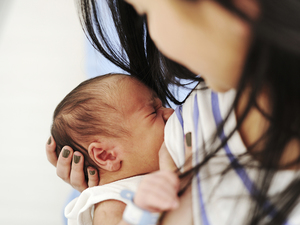Help! My Newborn Baby Doesn’t Want to Breastfeed!
One of the most distressing things that can happen to a new mom is a baby that doesn’t want to breastfeed. Often times a baby will be extremely sleepy after birth and not interested in the breast, or the baby will latch on to the breast and not suck at all. Either way, the baby is not breastfeeding — not taking any milk from the breast. There are a number of reasons why this could happen and there are quite a few things that you can do to help.
Why is Baby Not Breastfeeding?
The first important thing to remember is that when a baby is not breastfeeding, it’s always because something is preventing him from doing so. Never will a baby refuse the breast because he doesn’t like it or because the milk is not good.
There are many factors that could contribute to baby not breastfeeding after birth:
- C-section: babies born via c-section are often very sleep for the first day or two
- Difficult labor: after a normal birth with long and difficult labor, baby is often quite exhausted and needs to rest a bit first
- Pain medications: any pain medications that were given during labor are likely to make baby sleep. This includes epidurals! The worst effect is seen with narcotic pain medicines like pethidine (which is, coincidentally, the pain medication that is most often used in labor)
- Prematurity: if baby was born at less than 37 full weeks of pregnancy, there’s a good chance that his suckling skills have not matured 100%
- Separation from mom: if baby was taken away from you, his body may have gone in to a “shut down” – this happens when babies are stressed, and their bodies focus only on staying alive, not on feeding
How to Get Baby to Breastfeed
Always start with skin-to-skin
Start by putting the baby skin-to-skin and leave them there until they start breastfeeding. It is the single most effective solution for almost any breastfeeding problem. Skin-to-skin contact ensures that y9ur baby doesn’t get cold and that his blood sugar doesn’t fall – both of those things will make baby even more sleepy. Skin-to-skin contact also allows your body and baby’s body to talk to each other. Babies are born with all the reflexes that they need to be able to breastfeed effectively and skin-to-skin contact helps to activate those reflexes. Nine out of ten times this will be the only solution you need.
Get the milk flowing and feed the baby
When baby does not want to breastfeed immediately, others are usually quick to start pushing a bottle. If baby’s first proper sucking experience is on the bottle, it can be very difficult to get him back onto the breast. Baby is not going to go hungry within the first 24 hours. A baby needs only drops of milk – even a baby this is breastfeeding well will only take about 30ml in the first 24 hours. As long as baby is in skin-to-skin contact, very little can go wrong.
If the baby is still not breastfeeding by 6-8 hours after birth, it is a good idea to start expressing your breast milk so that you can stimulate your breasts to increase their milk production. Don’t worry if you can only get a drop or two of milk. That is quite normal. You can just sweep up those drops with your finger and put them in baby’s mouth. If you get more than a few drops, use a syringe or teaspoon to feed it to your baby. Continue pumping or hand expressing at least 8 times per 24 hours to ensure that you build a good milk supply. Feed the milk to baby with a syringe or spoon but avoid using a bottle.
Help baby to get to the breast
While baby is in skin-to-skin contact, watch him closely for signs that he’s ready to feed. Some feeding cues that you can look for are:
- Rooting: baby turns his head to the side and opens his mouth when something touches his cheek
- Chewing or sucking movements with the mouth
- Licking or mouthing your chest or his own hands
- Attempting to crawl to the breast
- Making moaning sounds almost like he’s about to cry
When baby shows these signs, it’s a good time to offer the breast. Bring baby closer to the breast so that he’s in a position where he can latch on the nipple without having to turn or tilt his head. When you have baby to the breast, first give him some time to explore. If you notice that baby is getting frustrated or struggling to latch on to the breast, you can help him out using some the techniques from this post.
Stimulate the sucking muscles
Sometimes the muscles of the face just need a bit of stimulation to wake them up and start baby sucking. Using your forefinger, stroke baby’s face gently but firmly in the following areas:
- Stroke the cheek in a line running from the center of the ear to the corner of the mouth
- Stroke the skin above the upper lip moving from the center of the lip to the corner of the mouth (repeat on both sides)
- Stroke the lower lip from left to right and from right to left
- Place a finger under baby’s chin and gently massage in small circles – this stimulates baby’s tongue from below
- Use your finer to tap baby’s lips – if baby opens his mouth and roots for your finger, allow him to suck on it for a bit (with the pad of your finger on his tongue and the nail at the palate) – once the baby is sucking rhythmically, try to slip the finger out of his mouth and the nipple in
When to get help
If your baby is still not latching after 48 hours, it is time to call in a professional. Try to get in touch with a Certified Lactation Consultant or IBCLC as soon as possible. In the meanwhile, keep expressing breast milk and feeding your baby. Don’t lose hope. With a bit of skilled help it really is possible to get almost any baby latched on and breastfeeding.
Get in touch for more help with breastfeeding, pregnancy and postpartum care and concerns.





